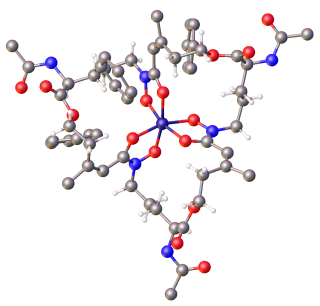
Pseudomonas is a genus of Gram-negative bacteria belonging to the family Pseudomonadaceae in the class Gammaproteobacteria. The 313 members of the genus demonstrate a great deal of metabolic diversity and consequently are able to colonize a wide range of niches. Their ease of culture in vitro and availability of an increasing number of Pseudomonas strain genome sequences has made the genus an excellent focus for scientific research; the best studied species include P. aeruginosa in its role as an opportunistic human pathogen, the plant pathogen P. syringae, the soil bacterium P. putida, and the plant growth-promoting P. fluorescens, P. lini, P. migulae, and P. graminis.

Siderophores (Greek: "iron carrier") are small, high-affinity iron-chelating compounds that are secreted by microorganisms such as bacteria and fungi. They help the organism accumulate iron. Although a widening range of siderophore functions is now being appreciated, siderophores are among the strongest (highest affinity) Fe3+ binding agents known. Phytosiderophores are siderophores produced by plants.

Burkholderia is a genus of Pseudomonadota whose pathogenic members include the Burkholderia cepacia complex, which attacks humans and Burkholderia mallei, responsible for glanders, a disease that occurs mostly in horses and related animals; Burkholderia pseudomallei, causative agent of melioidosis; and Burkholderia cepacia, an important pathogen of pulmonary infections in people with cystic fibrosis (CF). Burkholderia species is also found in marine environments. S.I. Paul et al. (2021) isolated and characterized Burkholderia cepacia from marine sponges of the Saint Martin's Island of the Bay of Bengal, Bangladesh.

Pseudomonas aeruginosa is a common encapsulated, Gram-negative, aerobic–facultatively anaerobic, rod-shaped bacterium that can cause disease in plants and animals, including humans. A species of considerable medical importance, P. aeruginosa is a multidrug resistant pathogen recognized for its ubiquity, its intrinsically advanced antibiotic resistance mechanisms, and its association with serious illnesses – hospital-acquired infections such as ventilator-associated pneumonia and various sepsis syndromes. P. aeruginosa is able to selectively inhibit various antibiotics from penetrating its outer membrane - and has high resistance to several antibiotics. According to the World Health Organization P. aeruginosa poses one of the greatest threats to humans in terms of antibiotic resistance.

Burkholderia cepacia complex (BCC) is a species complex consisting of Burkholderia cepacia and at least 20 different biochemically similar species of Gram-negative bacteria. They are catalase-producing and lactose-nonfermenting. Members of BCC are opportunistic human pathogens that most often cause pneumonia in immunocompromised individuals with underlying lung disease. Patients with sickle-cell haemoglobinopathies are also at risk. The species complex also attacks young onion and tobacco plants, and displays a remarkable ability to digest oil.

Burkholderia pseudomallei is a Gram-negative, bipolar, aerobic, motile rod-shaped bacterium. It is a soil-dwelling bacterium endemic in tropical and subtropical regions worldwide, particularly in Thailand and northern Australia. It was reported in 2008 that there had been an expansion of the affected regions due to significant natural disasters, and it could be found in Southern China, Hong Kong, and countries in America. B. pseudomallei, amongst other pathogens, has been found in monkeys imported into the United States from Asia for laboratory use, posing a risk that the pathogen could be introduced into the country.

Burkholderia cenocepacia is a Gram-negative, rod-shaped bacterium that is commonly found in soil and water environments and may also be associated with plants and animals, particularly as a human pathogen. It is one of over 20 species in the Burkholderia cepacia complex (Bcc) and is notable due to its virulence factors and inherent antibiotic resistance that render it a prominent opportunistic pathogen responsible for life-threatening, nosocomial infections in immunocompromised patients, such as those with cystic fibrosis or chronic granulomatous disease. The quorum sensing systems CepIR and CciIR regulate the formation of biofilms and the expression of virulence factors such as siderophores and proteases. Burkholderia cenocepacia may also cause disease in plants, such as in onions and bananas. Additionally, some strains serve as plant growth-promoting rhizobacteria.

Aerobactin is a bacterial iron chelating agent (siderophore) found in E. coli. It is a virulence factor enabling E. coli to sequester iron in iron-poor environments such as the urinary tract.

Ferrichrome is a cyclic hexa-peptide that forms a complex with iron atoms. It is a siderophore composed of three glycine and three modified ornithine residues with hydroxamate groups [-N(OH)C(=O)C-]. The 6 oxygen atoms from the three hydroxamate groups bind Fe(III) in near perfect octahedral coordination.

Phosphate solubilizing bacteria (PSB) are beneficial bacteria capable of solubilizing inorganic phosphorus from insoluble compounds. P-solubilization ability of rhizosphere microorganisms is considered to be one of the most important traits associated with plant phosphate nutrition. It is generally accepted that the mechanism of mineral phosphate solubilization by PSB strains is associated with the release of low molecular weight organic acids, through which their hydroxyl and carboxyl groups chelate the cations [an ion that have positive charge on it.] bound to phosphate, thereby converting it into soluble forms. PSB have been introduced to the Agricultural community as phosphate Biofertilizer. Phosphorus (P) is one of the major essential macronutrients for plants and is applied to soil in the form of phosphate fertilizers. However, a large portion of soluble inorganic phosphate which is applied to the soil as chemical fertilizer is immobilized rapidly and becomes unavailable to plants. Currently, the main purpose in managing soil phosphorus is to optimize crop production and minimize P loss from soils. PSB have attracted the attention of agriculturists as soil inoculums to improve the plant growth and yield. When PSB is used with rock phosphate, it can save about 50% of the crop requirement of phosphatic fertilizer. The use of PSB as inoculants increases P uptake by plants. Simple inoculation of seeds with PSB gives crop yield responses equivalent to 30 kg P2O5 /ha or 50 percent of the need for phosphatic fertilizers. Alternatively, PSB can be applied through fertigation or in hydroponic operations. Many different strains of these bacteria have been identified as PSB, including Pantoea agglomerans (P5), Microbacterium laevaniformans (P7) and Pseudomonas putida (P13) strains are highly efficient insoluble phosphate solubilizers. Recently, researchers at Colorado State University demonstrated that a consortium of four bacteria, synergistically solubilize phosphorus at a much faster rate than any single strain alone. Mahamuni and Patil (2012) isolated four strains of phosphate solubilizing bacteria from sugarcane (VIMP01 and VIMP02) and sugar beet rhizosphere (VIMP03 and VIMP 04). Isolates were strains of Burkholderia named as VIMP01, VIMP02, VIMP03 and VIMP04. VIMP (Vasantdada Sugar Institute Isolate by Mahamuni and Patil) cultures were identified as Burkholderia cenocepacia strain VIMP01 (JQ867371), Burkholderia gladioli strain VIMP02 (JQ811557), Burkholderia gladioli strain VIMP03 (JQ867372) and Burkholderia species strain VIMP04 (JQ867373).

Pyoverdines are fluorescent siderophores produced by certain pseudomonads. Pyoverdines are important virulence factors, and are required for pathogenesis in many biological models of infection. Their contributions to bacterial pathogenesis include providing a crucial nutrient, regulation of other virulence factors, supporting the formation of biofilms, and are increasingly recognized for having toxicity themselves.

2,4-Diacetylphloroglucinol or Phl is a natural phenol found in several bacteria:
In molecular biology, Toxic Small RNA(tsRNA, not to be confused with tRNA-derived small RNA) is a family of trans-encoded small non-coding RNA found exclusively in intergenic regions of Betaproteobacteria. Several paralogous loci may encode similar tsRNAs in each coding genome. Typically, each species of Burkholderia has 3-5 homologous tsRNAs. Experiments with four species of the Burkholderia lineage showed conserved and constitutive expression of tsRNAs in logarithmic growth phases.

Albomycins are a group of naturally occurring antibiotics belonging to the class of sideromycins, which are "compounds composed of iron carriers called siderophores linked to antibiotic moieties". They are particularly effective against Gram-negative bacteria of the family Enterobacteriaceae and few Gram-positive bacteria such s Streptococcus pneumoniae, Bacillus subtilis and Staphylococcus aureus. In 2000 a group of scientists from SmithKline Beecham Pharmaceuticals, UK reported that the antibiotic part of albomycin in vitro can inhibit seryl-tRNA synthetase from both eukaryotic and prokaryotic representatives.
Siderocalin(Scn), lipocalin-2, NGAL, 24p3 is a mammalian lipocalin-type protein that can prevent iron acquisition by pathogenic bacteria by binding siderophores, which are iron-binding chelators made by microorganisms. Iron serves as a key nutrient in host-pathogen interactions, and pathogens can acquire iron from the host organism via synthesis and release siderophores such as enterobactin. Siderocalin is a part of the mammalian defence mechanism and acts as an antibacterial agent. Crystallographic studies of Scn demonstrated that it includes a calyx, a ligand-binding domain that is lined with polar cationic groups. Central to the siderophore/siderocalin recognition mechanism are hybrid electrostatic/cation-pi interactions. To evade the host defences, pathogens evolved to produce structurally varied siderophores that would not be recognized by siderocalin, allowing the bacteria to acquire iron.
Burkholderia stagnalis is a bacterium from the genus of Burkholderia. Burkholderia stagnalis belongs to the Burkholderia cepacia complex.
Burkholderia territorii is a bacterium from the genus of Burkholderia. Burkholderia territorii belongs to the Burkholderia cepacia complex.

Ferrichrome A is a siderophore in the ferrichrome family. Iron is an essential element for the survival and proliferation of organisms. Microorganisms produce and secrete potent iron chelators, also known as siderophores, to aid in the sequestration and increase bioavailability of iron. Since the discovery of ferrichrome in 1952, the ferrichrome family of siderophores contains at least 20 structurally distinct members of cyclic hexapeptides that chelate ferric iron via an octahedral coordination geometry through the oxygen atoms of the hydroxyl and the acyl groups of the three ornithine residues. Ferrichrome A was found as one of the two siderophores produced by the biotrophic basidiomycete Ustilago maydis during its saprotrophic growth phase. U. maydis is the causative agent of corn smut.

Cefiderocol, sold under the brand name Fetroja among others, is an antibiotic used to treat complicated urinary tract infections when no other options are available. It is indicated for the treatment of multi-drug-resistant Gram-negative bacteria including Pseudomonas aeruginosa. It is given by injection into a vein.

Rhizoferrin is an organic compound with the formula (CH2CH2NHCOCH2C(OH)(CO2H)CH2CO2H)2. It is multifunctional molecule with two secondary alcohols, four carboxylic acid groups, and two amide groups. In aqueous solution, it is highly ionized, but the term rhizoferrin is still applied to these species.
















